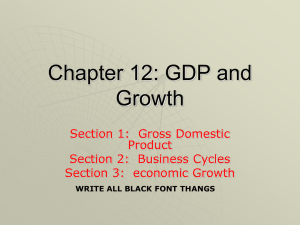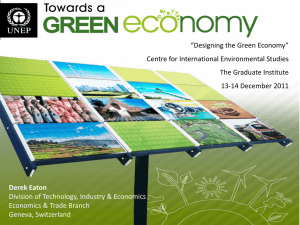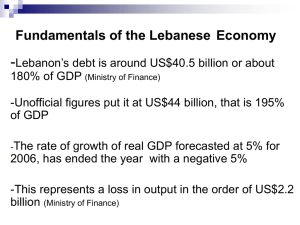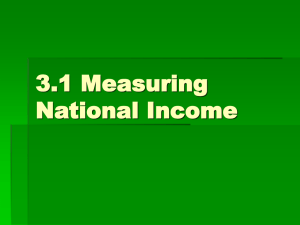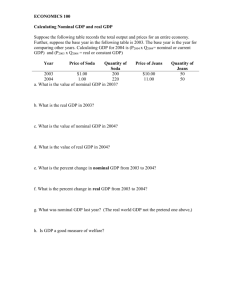SEJARAH PEMIKIRAN EKONOMI Prof. Jamal
advertisement
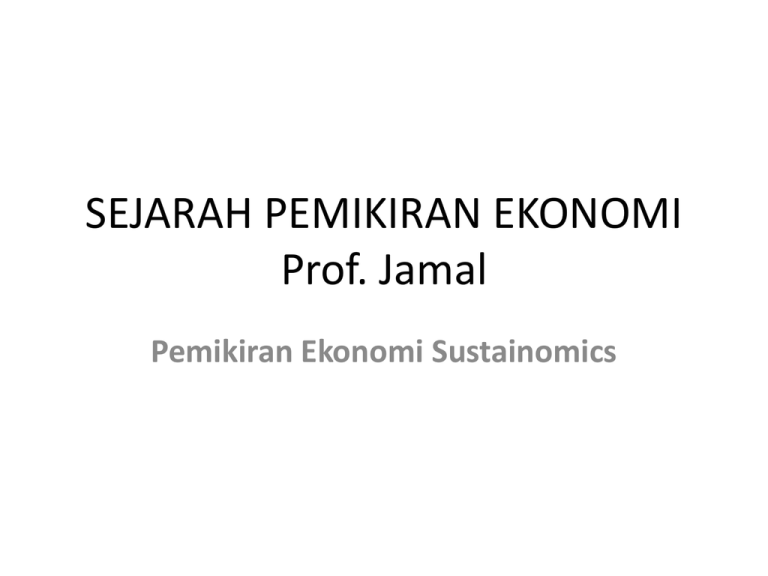
SEJARAH PEMIKIRAN EKONOMI Prof. Jamal Pemikiran Ekonomi Sustainomics Latarbelakang • Economic Growth vs Economic Development – Economic growth – reflected by GDP (quantity) indicator – Economic development – qualitative aspects (e.g income per capita, quality of life indicators) • Sustainable Development – Development that meets the needs of the present generation as well as the needs of future generation – Such a development requires the balanced treatment/consideration of social, ecological and economic dimensions – No one dimension is more important than the other • Background of Sustainable Development concept – Development experiences of countries - high economic growth does not always lead to trickle down effects in terms of poverty and income gap reduction – High economic growth that leads to ecological and social degradation will not be sustainable – Importance of ecological resiliency – to provide inputs for economic processes, waste sink and natural amenities – Sustainomics – sustainable economics and business (coined by Prof Mohan Munasinghe) SUSTAINOMICS - Proposed Approach for Malaysia Prof. Mohan Munasinghe: Adopt the balanced development concept—“Integrated Solutions for Sustainomics”, i.e. apply “Sustainomics” framework for more sustainable economic development-combination of sound economic policy management to address vulnerabilities and risks for stability in economic growth, social framework of governance, inclusion and institutional values, and building environmental resilience through adopting concepts on bio-diversity, optimizing rewards from natural resources and eliminating pollution. TOKOH • • • • • • Herman E. Daly David W. Pearce Karl-Goran Maler Partha Dasgupta Jeffery Vincent Mohan Munasinghe SUSTAINABLE DEVELOPMENT – THE IN THING Economic Management: Growth, Efficiency, Stability Sustainable Development: Social Empowerment: Inclusiveness, Governance, Social and Moral Values at Individual and Institutional Levels Growth with economic stability, environment protection Environment: Resilience, Optimise Natural Resources, Address Pollution, Make environment key component of policies SUSTAINABLE DEVELOPMENT WORLDVIEW Economy 3 1 Submission to God Interlinkages: 1. Intragenerational Equity 2. Intergenerational Equity 3. Internalizing Environmental Externalities * Environmental Policies * Economywide Policies * Environmental Valuation Environment Social 2 Enablers of SD Efficient Monetary/Financial System, Good Governance, Politics, Institutions, Knowledge, Technology SYSTEMS APPROACH TO AGRICULTURE – implication of Sustainomics Agriculture Multi-functionality Food and Fiber (marketed benefits) Multi-functionality (non marketed benefits) Environmental Function Education Function Social Function Food Security Function Cultural Function Biodiversity Farmers/ Consumers Society at large THE NEW ECONOMIC MODEL (traits of Sustainomics) Mindset change is paramount – from partial (self-assertive) to system-wide thinking and values (integrative) LIVING BEYOND OUR MEANS? If you live within your means, you plan to be better off in the future Similarly, to maintain future well being, countries must operate within her means Fallacy of GDP measure? – Does not reflect welfare or true performance of an economy – It measures only the benefits of resource use – Depletion of natural and man made capital ignored. Likewise, environmental impacts – Does not reflect whether our economy is growing sustainably Appropriate national income (GDP) - the level of income that can be consumed without depleting our capital assets (natural + man made) -> Green GDP Alternatives to GDP Measure Green GDP = GDP - Dm - Dn - E; where; Dm = depreciation of man-made capital Dn = Depletion of natural capital E = environmental costs Formally known as Adjusted Net Domestic Product (ANDP) Gross Savings –> GDP minus public and private consumption. How much income we set aside for future use? Does this tell anything about sustainability of economic growth? How about Genuine Savings? Holistic Project/Policy Appraisals • Conventional vs Extended Social BCA • Decision rules in CBA • Notion of Environmental Values – Use Values (UV) • Direct Use Values • Indirect Use Values – – – – Option Values (OV) Bequest Values (BV) Quasi Option Values (QOV) Existence Values (EV) • Total Economic Values (TEV) = UV + OV +BV +QOV +EV EXTENDED SOCIAL BENEFIT COST ANALYSIS n NPV = NPV Bt Ct Dt Et r t [(B t=0 = = = = = = = n t - Ct)/(1+r)t] + [(D t=0 t - Et)/(1+r)t] Net Present Value Marketed (financial) benefits in year t Financial Costs in year t Non-marketed benefits in year t Non-marketed costs in year t social discount rate time (year) • Project desirable economically if NPV > 0. • If Dt and Et are ignored, with NPV >0, only desirable from the market/financial perspective -> not consistent with sustainability • Conventionally, Bt and Ct are mainly Direct Use Values Emerging Macroeconomic issues in Malaysia (1) Shift towards more localized approaches (2) Addresses inequalities and social needs (3) Promote more competition, innovation, entrepreneurship and private sector-led development (4) Strengthening regional and cultural links especially with India, China and the Gulf (5) Make better use of the existing production base in manufacturing and natural resources (6) Measures of macro sustainability







